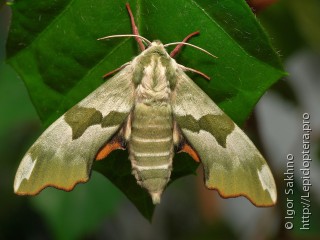Mimas tiliae
Taxonomy
class Insecta
Species name(s)
Mimas tiliae (Linnaeus, 1758) = Sphinx tiliae Linnaeus, 1758 = ulmi (Heydenreich, 1851) = maculata (Wallengren, 1863) = tilioides (Holle, 1865) = pechmanni (Hartmann, 1879) = bipunctata (Clark, 1891) = contripuncta (Clark, 1891) = costipuncta (Clark, 1891) = obsoleta (Clark, 1891) = suffusa (Clark, 1891) = brunnea (Caradja, 1893) = immaculata (Bartel, 1900) = brunnescens (Staudinger, 1901) = exstincta (Staudinger, 1901) = brunnea-centrpuncta Tutt, 1902 = brunnea-costipuncta Tutt, 1902 = brunnea-marginepuncta Tutt, 1902 = brunnea-obsoleta Tutt, 1902 = brunnea-transversa Tutt, 1902 = lutescens Tutt, 1902 = margine-puncta Tutt, 1902 = pallida-centripuncta Tutt, 1902 = pallida-costipuncta Tutt, 1902 = pallida-marginepuncta Tutt, 1902 = pallida-obsoleta Tutt, 1902 = pallida-transversa Tutt, 1902 = semiobsoleta Tutt, 1902 = virescens-centripuncta Tutt, 1902 = virescens-maculata Tutt, 1902 = virescens-marginepuncta Tutt, 1902 = virescens-obsoleta Tutt, 1902 = virescens-transversa Tutt, 1902 = atroviridis Closs, 1911 = trimaculata (Brombacher, 1915) = bimaculata Gillmer, 1916 = bimarginalis Gillmer, 1916 = colon Gillmer, 1916 = constricta Gillmer, 1916 = excessiva Gillmer, 1916 = fasciata Gillmer, 1916 = inversa Gillmer, 1916 = pseudo-trimaculata Gillmer, 1916 = semicentripuncta Gillmer, 1916 = clara Closs, 1917 = discifera Closs, 1917 = roseotincta (Schawerda, 1922) = rufobrunnea Lenz, 1925 = griseothoracea Cabeau, 1931 = vitrina Gehlen, 1931 = virescens-bipuncta Lempke, 1937 = diluta Cockayne, 1953 = rubra Cockayne, 1953 = Mimas tiliae montana Daniel & Wolfsberger, 1955 = pallida-maculata Lempke, 1959 = postobscura Lempke, 1959 = pseudobipunctata Lempke, 1959 = typica-puncta Lempke, 1959 = angustefasciata Vilarrubia, 1973 = bicolor Vilarrubia, 1973 = latefasciata Vilarrubia, 1973 = reducta Vilarrubia, 1973 = rufescens Vilarrubia, 1973. [9, 10]
Lime Hawk-moth.
urn:lsid:insecta.pro:taxonomy:2846
Expansion
This species marks on the maps: 6.
Zoogeographical regions
Palaearctic.
Russia regions
#1. Kaliningradsky; #4. Evropeisky Severo-Zapadny; #7. Evropeisky yuzhno-tayozhny; #8. Evropeisky Tsentralny; #9. Evropeisky Tsentralno-Chernozyomny; #10. Sredne-Volzhsky; #11. Volgo-Donsky; #12. Nizhnevolzhsky; #13. Zapadno-Kavkazsky; #14. Vostochno-Kavkazsky; #16. Sredne-Uralsky; #17. Yuzhno-Uralsky; #19. Sredneobsky; #20. Yuzhno-Zapadnosibirsky; #22. Krasnoyarsky; #23. Predaltaisky.
Forewing length
36—40 mm.
Wingspan
64—74 mm.
Primary colors
Red, Green, Brown/Gray/Black.
Flight time
| January | February | March | April | May | June | July | August | September | October | November | December |
Larva lifespan
| January | February | March | April | May | June | July | August | September | October | November | December |
Over-wintering stage
Pupa.
Detailed information with references
Distribution
Imago Habitus and Differences from alike species
General info about Imago
Imago lifespan
General info about Larva
Larva food plants / other food objects
Larva lifespan
Egg
Overwintering stage
Authors
Initial species uploading to the site: Peter Khramov.
Text data: Peter Khramov.
The species characteristics formalization: Peter Khramov, Sergei Kotov, Vasiliy Feoktistov.
References
- [1] O. Karsholt, J. Razowski (eds.), 1996. The Lepidoptera of Europe: a distributional checklist
- [3] Каталог чешуекрылых (Lepidoptera) России. Под ред. С. Ю. Синёва. СПб.; М.: Товарищество научных изданий КМК, 2008
- [5] Райххолф-Рим Х. Бабочки. М.: Астрель, 2002
- [9] Tree of Life (funet.fi), 2012
- [10] de Jong, Y.S.D.M. (ed.) (2011) Fauna Europaea version 2.4 (faunaeur.org)
- [28] Moths and Butterflies of Europe and North Africa (leps.it), 2012
Comments
Note: you should have a Insecta.pro account to upload new topics and comments. Please, create an account or log in to add comments
Mimas tiliae photos




































































All the photos of the species in large size
Please, create an account or log in to upload your photo


